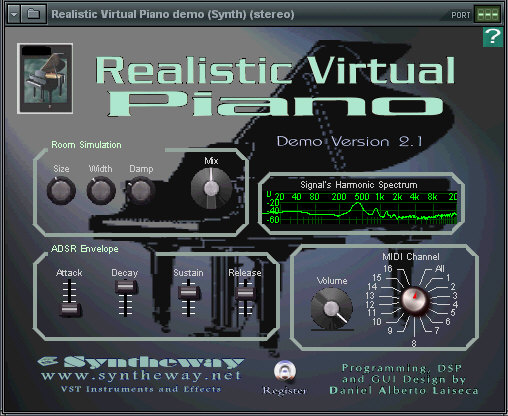
Syntheway has introduced Realistic Virtual Piano v2.5 VSTi, an Acoustic Grand Piano emulation VST instrument for Windows and Linux O.S.
Details and demos below.
If you’ve used Syntheway Realistic Virtual Piano VSTi, leave a comment with your thoughts!
What’s new in version 2.5:
- Added new Yamaha Grand Piano module.
- Kawai Grand Piano module have been totally re-sampled.
- Added Piano Selector option in GUI.
- Minor adjustments in GUI as well as in default parameters.
- Fixed a few minor bugs.
Main Features:
- Modeled on mastered Piano samples (normalized and noise-reduced). Based on PCM recordings of a Kawai and Yamaha Grand Pianos after it has been meticulously tuned and adjusted.
- To achieve such a remarkably authentic piano sound, has full length sustain samples, no loops (natural decay), stored in 16 bits and 44.100 KHz.
- ADSR envelope generator with Attack, Sustain, Decay and Release parameters and several modulation targets.
- Optimized CPU and memory usage. Stability: complete. Uses memory efficiently without sacrificing quality. Unlike many other piano modules and samplers, this piano will never overload CPU.
- Good live performances: never stick notes, never break the sound.
- Affordable price and user-friendly attitude are sure to attract many musicians
- Integrated, variable room simulation. Free variation of acoustic ambience thanks to complete separation of piano and room. Small rooms can be modeled just as accurately as larger spaces.
- Customizable with user controls for: size room, width room, damping factor & mixer, used to create psycho-acoustic models in the DSP environment, without having to load up any other plug-ins.
- MIDI Automation: Added complete MIDI CC#.
A demo version of Syntheway Realistic Virtual Piano VSTi is available.

I really want to learn to play the piano, do you have any tutorials or know of any?
The configuration and version is good .. it seems to be really magical while playing but do try to input more if you can.
The Treble Clef has the G note as its reference point. This note is on the second line from the bottom of the five line Treble Clef staff. The Bass Clef has the F notes as its reference point. This note is on the second line from the top of the five line Bass Clef staff. Every other note on either staff is easily located from these points.